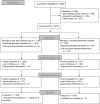The effects of a multilingual telephone quitline for Asian smokers: a randomized controlled trial
- PMID: 22282542
- PMCID: PMC3283535
- DOI: 10.1093/jnci/djr530
The effects of a multilingual telephone quitline for Asian smokers: a randomized controlled trial
Abstract
Background: Although telephone counseling services (quitlines) have become a popular behavioral intervention for smoking cessation in the United States, such services are scarce for Asian immigrants with limited English proficiency. In this study, we tested the effects of telephone counseling for smoking cessation in Chinese-, Korean-, and Vietnamese-speaking smokers.
Methods: A culturally tailored counseling protocol was developed in English and translated into Chinese, Korean, and Vietnamese. We conducted a single randomized trial embedded in the California quitline service. Smokers who called the quitline's Chinese, Korean, and Vietnamese telephone lines between August 2, 2004, and April 4, 2008, were recruited to the trial. Subjects (N = 2277) were stratified by language and randomly assigned to telephone counseling (self-help materials and up to six counseling sessions; n = 1124 subjects) or self-help (self-help materials only; n = 1153 subjects) groups: 729 Chinese subjects (counseling = 359, self-help = 370), 848 Korean subjects (counseling = 422, self-help = 426), and 700 Vietnamese subjects (counseling = 343, self-help = 357). The primary outcome was 6-month prolonged abstinence. Intention-to-treat analysis was used to estimate prolonged abstinence rates for all subjects and for each language group. All statistical tests were two-sided.
Results: In the intention-to-treat analysis, counseling increased the 6-month prolonged abstinence rate among all smokers compared with self-help (counseling vs self-help, 16.4% vs 8.0%, difference = 8.4%, 95% confidence interval [CI] = 5.7% to 11.1%, P < .001). Counseling also increased the 6-month prolonged abstinence rate for each language group compared with self-help (counseling vs self-help, Chinese, 14.8% vs 6.0%, difference = 8.8%, 95% CI = 4.4% to 13.2%, P < .001; Korean, 14.9% vs 5.2%, difference = 9.7%, 95% CI = 5.8% to 13.8%, P < .001; Vietnamese, 19.8% vs 13.5%, difference = 6.3%, 95% CI = 0.9% to 11.9%, P = .023).
Conclusions: Telephone counseling was effective for Chinese-, Korean-, and Vietnamese-speaking smokers. This protocol should be incorporated into existing quitlines, with possible extension to other Asian languages.
Figures


Comment in
-
Enhancing the effectiveness of smoking cessation interventions: a cancer prevention imperative.J Natl Cancer Inst. 2012 Feb 22;104(4):260-2. doi: 10.1093/jnci/djr558. Epub 2012 Jan 25. J Natl Cancer Inst. 2012. PMID: 22282541 Free PMC article. No abstract available.
References
-
- Ludman EJ, Simon GE, Tutty S, Von Korff M. A randomized trial of telephone psychotherapy and pharmacotherapy for depression: continuation and durability of effects. J Consult Clin Psychol. 2007;75(2):257–266. - PubMed
-
- Zhu SH, Stretch V, Balabanis M, Rosbrook B, Sadler G, Pierce JP. Telephone counseling for smoking cessation: effects of single-session and multiple-session interventions. J Consult Clin Psychol. 1996;64(1):202–211. - PubMed
Publication types
MeSH terms
Grants and funding
LinkOut - more resources
Full Text Sources
Medical
Miscellaneous

